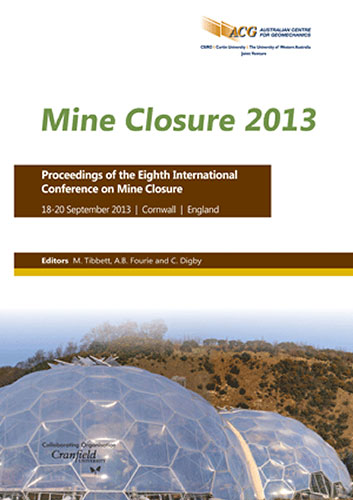A rigorous, systematic and integrated methodology to assess viable land use options for mine closure: a case study from Suriname

|
Authors: Stewart, WI; Watt, C; Parshley, JV; Lassiter, P; George, J; Nandlal, A; Van Vlaenderen, H Paper is not available for download Contact Us |
DOI https://doi.org/10.36487/ACG_rep/1352_05_Stewart
Cite As:
Stewart, WI, Watt, C, Parshley, JV, Lassiter, P, George, J, Nandlal, A & Van Vlaenderen, H 2013, 'A rigorous, systematic and integrated methodology to assess viable land use options for mine closure: a case study from Suriname', in M Tibbett, AB Fourie & C Digby (eds), Mine Closure 2013: Proceedings of the Eighth International Seminar on Mine Closure, Australian Centre for Geomechanics, Cornwall, pp. 41-53, https://doi.org/10.36487/ACG_rep/1352_05_Stewart
Abstract:
Suralco L.L.C. (a subsidiary of Alcoa Inc.) is currently preparing an Integrated Closure Plan (ICP) Framework for its landholdings and mining concessions located principally within the Commewijne, Marowijne and Para Districts of Suriname. The purpose of the ICP Framework process is to act as an overarching template that can be followed to determine acceptable land use options and completion criteria for mine closure based on the physical, biophysical and socio-economic conditions of each disturbed mine site. The ICP Framework was built around a concise decision tree logic, permitting a very structured approach. Due to the array of potential post-closure land use options, a key component of the ICP Framework was the identification and assessment of viable and sustainable post-closure land uses. The determination of post-closure land uses is recognised in the literature and by practitioners as an important part of the mine closure planning process. However, it is often undertaken in an ad hoc manner and the process poorly documented. The need for rigorous methodologies is particularly important where clear regulatory criteria defining closure are not readily available. An innovative approach to assessing post-closure land use options in the form of a preliminary land use viability assessment tool (PLUVAT) is detailed that enabled an unprecedented level of integration across all the applicable disciplines and delivered a well-documented result that has responded well to both regulatory and stakeholder scrutiny and that promises to become a preferred model to define acceptable rehabilitation of mined areas in this region. The benefits of this approach to evaluating and documenting post-closure land use options and the high level of integration achieved across the various biophysical, socio-economic and technical disciplines are also explored.
References:
Asami, Y. (2010) City Planning Theory: Incentive Compatible Planning System in Proceedings: W101 - Special Track 18th CIB World Building Congress, May 2010, Salford, UK.
Commonwealth of Australia (2006a) Mine Closure and Completion: Leading Practice Sustainable Development Program for the Mining Industry, Canberra, Australia.
Commonwealth of Australia (2006b) Mine Rehabilitation: Leading Practice Sustainable Development Program for the Mining Industry, Canberra, Australia.
Department for Communities and Local Government: London (2009) Multi-criteria Analysis: A Manual, London.
FAO (Food and Agriculture Organization) (2000) Land Cover Classification System (LCCS): Classification Concepts and User Manual, Rome.
Government of Western Australia (2011) Guidelines for Preparing Mine Closure Plans, Department of Mines and Petroleum, Perth, Australia.
Herndon, J.D. (2011) Mixed-Use Development in Theory and Practice: Learning from Atlanta’s Mixed Experiences (Applied Research Paper).
Hofstad, H. (2012) Compact city development: high ideals and emerging practices, European Journal of Spatial Development, October.
ICMM (International Council on Mining and Metals) (2008) Planning for Integrated Mine Closure: Toolkit, London.
ICMM (International Council on Mining and Metals) (2011) Mining: Partnerships for Development Toolkit, London.
IFC (International Finance Corporation) (2007) The IFC and World Bank Environmental Health and Safety (EHS) Guidelines for Mining, Washington, DC.
IUCN (International Union for Conservation of Nature) (2012) The IUCN Red List of Threatened Species. Version 2012.2, viewed 17 October 2012, .
Maczkowiack, R.I., Smith, C. and Erskine, P.D. (2012) Risk assessment models for post-mining land use, in Proceedings Life-of-Mine 2012, Australasian Institute of Mining and Metallurgy, Melbourne, pp. 33–42.
Robertson, A. and Shaw, S. (2007) Mine Closure, Infomine e-book.
Sener, B. (2004) Landfill Site Selection by Using Geographic Information Systems, M.Sc. Thesis, Middle East Technical University.
Spackman, M., Dodgson, J., Pearman, A. and Phillips, L. (2000) DTLR Multicriteria Analysis Manual, National Economic Research Associates Report.
UNEP (United Nations Environment Programme) (2005) Mining for Closure: Policies, Practices and Guidelines for Sustainable Mining Practices and Closure of Mines, Nairobi.
USEPA (United States Environmental Protection Agency) (2012) Ecological Risk Assessment – Glossary of Terms, Chicago, viewed 27 June 2013, .
© Copyright 2024, Australian Centre for Geomechanics (ACG), The University of Western Australia. All rights reserved.
View copyright/legal information
Please direct any queries or error reports to repository-acg@uwa.edu.au
View copyright/legal information
Please direct any queries or error reports to repository-acg@uwa.edu.au